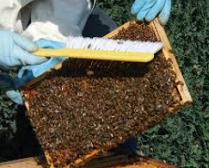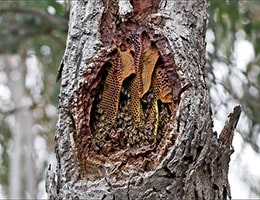 The Breton concept of kôlôen-wénan is formed from the words kôlô (which can be translated as “straw” ) and wénan (translatable as “bees” ). This notion led to the Celtic kolmēnā , which came to our language as a beehive .
The Breton concept of kôlôen-wénan is formed from the words kôlô (which can be translated as “straw” ) and wénan (translatable as “bees” ). This notion led to the Celtic kolmēnā , which came to our language as a beehive .
The place where the bees live is called a hive. This is the location occupied by a colony of these insects: the colony in question can even be called a hive. About 80,000 bees can live in the hives, including drones , workers and the queen bee .
Worker bees are the most numerous in a hive. They are the infertile females who are dedicated, among other activities, to cleaning and protecting the hive, building the wax combs and producing royal jelly. The drones, for their part, are the male bees, which fertilize the queen bees.
Beekeepers are individuals dedicated to raising bees. These people can create apiaries, also called apiaries , which are the spaces where the hives are distributed.
It is possible to differentiate between rustic hives (developed by bees spontaneously and naturally, without the participation of humans ) and artificial hives (made by man with the intention of obtaining the honey produced by bees). In this second group we can distinguish between hives with mobile combs and hives with fixed combs , which can also be horizontal, vertical or reproduction hives .
When an elderly queen bee leaves a hive with a group of workers to develop another colony, a swarm is formed through a process known as swarming .
It is important to note that the way in which bees build their hives is not very similar to that used by other social insects , such as ants and bumblebees. As mentioned in the previous paragraph, the start of a new swarm and, consequently, a colony occurs when an elderly queen bee leaves her hive along with many workers, leaving the younger queen in charge.
Human-made hives have several distinct parts, which can be purchased separately or made at home, depending on the level of skill of each beekeeper :
 * the ground and flight board;
* the ground and flight board;
* the lower super (also called brood chamber );
* the honey life increase;
* the interlid, which has a hole through which it is possible to feed the bees in particular cases. One of the most common materials for its manufacture is wood;
* the roof;
* mobile tables.
Once beekeepers make or purchase an artificial hive, it's time to find the swarm. To do this, they check trees where there are natural hives and use a net similar to that used to hunt butterflies or they approach the hive and direct the swarm inside with the help of smoke.
There are several procedures used to trap bees and get them to adapt to their new habitat, so that they can start working on honey production. Needless to say, beekeeping is an activity that deprives bees of their freedom and is therefore strictly opposed by animal rights activists.
The writer Camilo José Cela published a novel titled La colmena in 1951 through the publishing house Emecé Editores. Given its content, which makes various references to topics not tolerated at that time by the Franco dictatorship, the book could not be published in Spain until 1955, when Manuel Fraga was appointed minister of the interior. Broadly speaking, we can say that the work is fragmented into many short anecdotes that intersect with each other, as if they were the cells of a beehive.
